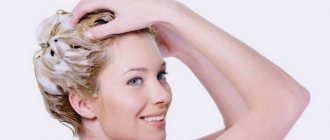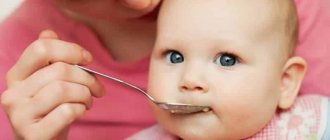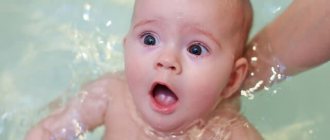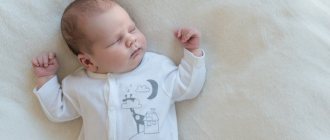Why doesn't your baby want to wash his hair?
You cannot scold a child if he is afraid to bathe or wash his hair.
You cannot scold a child if he refuses to wet his hair. This approach will only make the situation worse. Most often, refusal is associated with the fear that water will get into the eyes, nose or mouth, and that the child will choke.
There are other reasons related to the development and maturation of the baby:
- the emergence of a sense of boundaries and the manifestation of one’s own “I” - from 2-3 years old, the baby may refuse to wash his hair, wanting to do it himself;
- sudden fear of water is a condition similar to temporary phobia, developing between 3 and 5 years.
Sometimes the reason is due to the fact that the baby does not like the cosmetic product.
In any case, the problem can be solved using different approaches.
Why do children cry: main reasons
Washing your hair without tears is possible
A child’s categorical refusal to wash his hair or hysterics that appear during the process most often have a specific basis.
Stinging soap
Foamed shampoo, if it gets on the mucous membrane of the eyes, can cause irritation and pain. Such unpleasant sensations are very stressful for children. They get scared and immediately start crying.
Water gets into your nose and mouth
When washing your hair, if it is tilted forward, streams of water flow directly onto your face and can enter your mouth and nose. The child experiences a feeling of shortness of breath and a fear of choking. This provokes hysteria.
Water getting into ears
Such sensations are unpleasant even for an adult. If a son or daughter is prone to otitis media, this process can result in much more serious consequences. Water remaining in the ears, under certain conditions, can lead to an inflammatory process.
Painful sensations lead to the baby’s refusal to undergo such procedures.
Advice from psychologists
So that the baby is not afraid of water, you can swim with him.
You need to start eliminating the problem with the right attitude. You cannot yell at a child or force him. It is better to turn the process into exciting entertainment. Reading books and watching themed cartoons will help create the mood.
If a child of 2 or 3 years old does not allow you to wash your hair, you should remember these tips:
- It is necessary for the baby to get used to water - its amount is gradually increased during the procedure. First, you can wash your hair without shampoo.
- If the child refuses, you should set an example: ask him to wash his mom or dad’s hair so that he understands that there is nothing to be afraid of.
- Try to give your child freedom of action - to wet or soap their hair themselves.
- Children should be praised after a successful bath.
- After each procedure, you should say that it was not painful, scary, and the liquid did not get anywhere.
Psychological advice is concerned with influencing the child's opinion and understanding. You can also give practical recommendations that will require attention from parents.
For children 4-5 years old, an additional approach can be taken. They bring their child to the store, where they give him the opportunity to choose his own detergent. You can also choose conditioner and other hair cosmetics if your baby shows interest. Reviews from some mothers claim that this particular method helped their children get rid of the problem.
You can play with an older child
If your baby is already 3-4 years old and still throws tantrums at the sight of shampoo, turn washing your hair into a fun game. Place a mirror at the baby's level and invite him to build funny figures out of foam. First, you can play with foam in the bath, and then invite your child to make a crown like a prince, ears like Mickey Mouse, or a comb like a chicken.
Read also: Games with a small child in the bath
How to help your child
One of the key rules for teaching a baby to wash his hair is the attentiveness of the parents. Hygiene procedures should not be allowed to cause stress. You should feel good, your mood should be on the rise.
Additionally, you should remind your child that they need to wash their hair, as well as take a full bath in the bathtub. This should be done 1-2 days before the planned procedure. It's important to emphasize how useful it is.
Protective visor for washing children's hair
Next steps:
- You need to talk to your child and try to find out why he doesn’t like washing his hair so much.
- You can prepare a reward, for example, say that after visiting the bath the baby will have an interesting game or another favorite activity.
- At the same time, you can tell a fairy tale that will help you understand how important it is to cleanse your hair. If your child is over 5 years old, you can study with him the structure of hair and the mechanism of its pollution.
- During the washing process, you can use the “train” method. The child sits in the bathtub, his mother is behind him, and in front of him is a doll or other toy. He soaps the doll's head while the mother washes the baby's hair.
- Another training method is to wash from bottom to top. This method is especially suitable for girls with medium and long hair. Begin washing while bathing, simply rinsing the curls with water from a ladle. At first only the tips, gradually moving to medium length.
- Additionally, you can take your favorite toys with you into the bath that are not afraid of water. Place them on the bottom, and then gradually draw in a little liquid, diverting the baby’s attention to the gameplay.
If no advice helps overcome fear, it makes sense to contact a professional child psychologist. The specialist will select a high-quality scheme for eliminating fear and find out the exact reason for this behavior. When following any recommendations, one should not forget that all children are individual.
Turning hair washing into a game
Let the child wash the doll's hair himself.
One of the best ways to wash a child's hair without tears is to first work out the situation on a soft toy or doll.
- It is important to emphasize that the toy constantly goes outside, which is why it gets dirty.
- However, the doll is afraid to wash her hair, because water will get into her eyes. So we need to help her with her problem.
- Now you need to show your child that you can wash your hair with water so that the drops do not get into your eyes.
At the same time, you should teach your baby to close his eyes tightly and pinch his ears or cover his nose with his fingers.
Useful tips
It is in your power to learn to negotiate with your child so that this procedure takes place without screaming, crying and according to his own will.
A few helpful tips will help you achieve this. But I want to immediately note that all children are different, so I cannot give a 100% guarantee.
- Step 1.
Pay attention to his well-being. If you initially know that your child will not agree to wash his hair, do not wait for an evening bath, as many parents usually do. Carry out this procedure in the morning or afternoon, when the child wakes up and is in a good spirit and mood. Then it is easier to transform this process into a game. Even if it goes badly, the baby will quickly calm down and switch to something interesting, and you won’t have to calm him down before going to bed at night. In the evening, you can have a regular bath, which the baby will only enjoy. - Step 2.
Don’t forget that a child is an individual and, like adults, can refuse something. Learn to respect his wishes! Tell us that washing your hair is a mandatory and very important procedure for health. Have this conversation 1-2 days before washing, and not the day before the procedure. If the child is 4-5 years old, you can explain the need to wash your hair using more serious and substantiated examples: talk about how hair works, which can lead to contamination. This approach will not only be effective, but also educational for him. - Step 3.
Try to find out the reason for the fear of this procedure. Moreover, if the child is still small, it is better to offer him several options to choose from, since he himself will not be able to explain. For example, you don’t like it when water gets into your ears, eyes, mouth, it stings, it’s scary with your eyes closed, etc. You can eliminate the cause if you exclude “your opinion” that all this is nonsense and the child came up with ideas for himself. - those are fears. - Step 4.
If you cannot persuade your child to do this, there is a simple method - invite your son or daughter to wash your hair. As a rule, children love such things, with the help of which they can temporarily feel like adults and allow themselves to do what their mother does to them. However, keep in mind that this method does not work for everyone. - Step 5.
Alternatively, you can offer to do something interesting after the water procedure. For example, wash the dolls’ heads or allow them to comb their hair, but on the condition that the child agrees to the wash. - Step 6.
While washing, ask your baby to tightly close his eyes and ears with his fingers, then tilt his head back. Remember, when he tilts his head forward, foamy water starts running down his eyes, so you need to react quickly and give him a towel to wipe his face. - Step 7.
Comment on the process itself: how you pour water on your head, wash each strand, your hair becomes clean, soft and fragrant. - Step 8.
If your baby is afraid of water getting into his ears and eyes, it is better to cover this area with a towel or diaper. - Step 9.
When he is ready to wash his hair on his own, give him this opportunity, but be sure to help him with this. Hold the shower, help rinse the foamy hair. This is an effective method, because there are children who compromise - you wash it yourself, and mom or dad helps. - Step 10.
And finally, I would like to add - to make this procedure a pleasure, offer new devices for watering the head (a cup, glass, milk bottle or ladle) with each wash. This will be a kind of exciting game that your child will look forward to every time.
How to wash your hair properly
To prevent water from getting on the face, you can use special devices.
There are two ways to wash children's hair. The main rule for this procedure is to do everything carefully, without sudden pouring of water and intensive soaping.
- Tilt your head back. In this case, the baby closes his eyes and covers his ears with his hands. You need to carefully pour water along the edge of the hair growth, washing off the product. You can apply shampoo in the same position.
- Lean forward. Some children prefer to wash their hair this way. Then, instead of ears, you should ask the child to pinch his nose and also close his eyes.
It is easier to wash long hair with your head tilted back, and short hair - forward.
To understand how your child can take a bath more comfortably, you need to talk to him. If the baby does not yet say words, you need to carefully monitor his reaction.
Tips on what techniques you can use
Special visors and caps can be a way out of the situation.
The experience of mothers shows that the approach to each child is individual. Gradually trying different methods, you can find one that will be comfortable for both you and your baby.
Using a special cap
There are a lot of such devices on the market now. They are like a visor that protects the child’s face and ears from water. Most of the hair remains open. The diameter of the product is adjustable.
By wearing this hat, your child can play with his toys and not even notice that you have washed his hair.
It happens that children do not like such hats and tear them off. Then you will have to look for another solution to the problem.
Change your head position
Invite your child to tilt his head back
Usually, during evening hygiene procedures, parents try to tilt the child’s head forward. This makes it easier for them to get their scalp and hair in order.
In this position, all the streams flow onto the face and cause discomfort in the child. Invite him to do the opposite, sit in the bathtub and throw his head back. In this position, all the water and foam will flow down. Nothing will get on your face or ears.
Some parents have difficulty with such experiments. It is uncomfortable for the child to hold his head in this position for a long time.
Keep a towel or diaper handy
Be sure to buy special children's cosmetics
Talk to your child and find out what exactly he doesn't like. Most often, children complain about water getting into their eyes and nose. Try to come to an agreement with him. Next time during this procedure, let him show with words or gestures when he is uncomfortable.
Your task at this moment is to remove the water hose and quickly give him a diaper or towel so that he can wipe his face. In any case, it will be wet and you will have to dry it, but this is better than hysterics and spoiled nerves of several family members at once.
Let your child be independent
Offer to wash your hair yourself
If your son or daughter has reached the age where they are trying to do everything themselves, encourage them to get their head in order on their own. Explain that you will be there and help if necessary, but he will do all the basic processes himself.
You will have the opportunity to help your baby, monitor his actions and work together to wash his hair as expected.
Useful devices
To prevent water from getting into your eyes and ears, parents can use special accessories:
- swimming goggles - selected according to age, suitable in size and tightly fitting to the face;
- a headband or visor for swimming - a rigid attachment that clasps the child’s head with an elastic band;
- a thickly folded towel - the child covers his face with it, and if water gets in, he can quickly wipe it off.
You can also wash off the shampoo not with a shower, but with a ladle or mug. In stores you can buy a special glass for washing children's hair.
If the baby suddenly begins to be afraid to wash his hair, parents need to figure out the source of the problem. In most cases, refusal to bathe is associated with the growth and development of the child, this goes away within 6-12 months. If he succumbs to severe stress, you should help the baby using psychological advice and practical recommendations from specialists.
Washing your hair without hysterics
How to wash a child's hair without tears and screams?
There are several rules that will help solve the problem:
- keep calm . The parents' task is to understand the child and show patience and tact;
- wash your hair in a good mood . Before going to the bathroom, you need to feed the baby and make sure that he is happy and healthy. The optimal time for hygiene procedures is after a morning or lunchtime nap, when the baby is in a good mood and in the mood to play;
- talk . If your child is old enough, you can discuss with him his reluctance to wash his hair. This will help to establish the cause of the discomfort and eliminate it, making hygiene procedures enjoyable for both parties;
- reduce the number of procedures . It is not necessary to wash your hair every day. Doctors recommend doing this as your skin and hair become dirty (up to once a week);
- monitor the water temperature . Do not use too hot or cold water while bathing;
- wash your hair properly . Throughout the entire procedure, the child should look up (in this case, streams of water and shampoo will flow not down the face, but down the back of the head). Some parents set up a kind of hair salon at home: they wash their hair over the sink, placing a soft towel under their neck;
- come up with a defense . The following devices will help protect your eyes from water and shampoo: a special visor, swimming goggles, and a diving mask. You can use cotton balls to protect your ears;
- buy suitable cosmetics . Many shampoos cause pain in the eyes and watery eyes, creating a dislike for water procedures. Therefore, doctors recommend choosing products labeled “no tears.”
How to fix the situation
By the age of three, the fear will pass. What to do before the age of three? If you organize the bathing process correctly so that the child is less afraid, you will survive three years calmly.
Important! You cannot use force or threats when putting your baby to bathe. Refuses - scold, cannot be forced. Persuade, explain, convince, distract. Screams, force, and threats from parents increase fear, the desire to resist, and cry. Keep calm, be patient.
Give your baby time to forget negative emotions. Don't think about washing your hair for two weeks. Let him play with water, foam, toys. We wash after fourteen to fifteen days. We try to wash our hair, distracting with toys, pictures, and game elements. We use shampoo that does not irritate the eyes.
Make bathing comfortable. Monitor the water temperature. Sudden changes should not be allowed. Babies are washed at a temperature of 38 degrees.
Let the baby feel pleasant emotions, feel positive. Give it a bath when your little one is in a good mood, not tired, hungry, or drowsy.
A selection of gaming techniques
If a child is afraid to wash his hair, use a game to make the washing process easier.
- Invite the researcher to lather the hair of your favorite doll. We carry out all the necessary procedures. Undress and put in a bowl. Pour water and soap your hair. Wash off with water and wrap in a towel. We dry our hair. We comment on all the actions, how the doll likes to swim, she is clean, she has beautiful hair.
- You can also sit on a train and wash your hair like this: baby to the doll, and you to the baby.
- Ask an assistant (if your age allows) to soap your hair. He will pour water on your hair and lather it. And also wash off the foam and wrap it in a towel. The baby will blow on his hair with a hairdryer and dry it. By your example you will show that there is nothing to be afraid of.
- Bathing together encourages babies. Sitting with your child in the bathroom, you can gently soap his hair. He will feel you close and not be afraid (an option is to wash each other’s hair at the same time while sitting in the bathroom).
- If the bath allows, squeeze one drop of toothpaste onto the wall higher than the fidget's eyes, but so that he can reach it with his hand. Turn your baby to face the wall, give him a brush and let him paint with his head held high. It will be tilted back and will be convenient for you to rinse. In the meantime, while the child is interested, you can quickly take a bath.
- Does your baby do everything on his own? In the bathroom, you can direct it “me” to wash your hair. Let the assistant water the hair himself, lather himself and rinse off the foam. Then, dressed in pajamas, he dries his own hair. Help the little one if you see that he is having a hard time.
- When the hair is in foam, you can build a funny design from it (mohawk, protruding forelock, horns) and show it in the mirror.
- Playing diver will distract the fidget from unpleasant sensations. Put a mask or swimming goggles on your baby and the problem of water getting into the eyes will be solved.
- Colored bath foam has appeared on sale. While the little one is looking at it enthusiastically, you will have time to wash his hair. This foam has not only an attractive bright color, but also a delicious aroma.
- Offer to float on your back. The water will rinse your soapy hair on its own.
Now washing your child’s is not a problem, but another great reason to have a good time with your baby. Be healthy!
Read: Why does a child cry in his sleep?
Shampoo should be not only useful, but also attractive
Nowadays, there are baby shampoos that do not contain dyes or fragrances. Of course, they are completely harmless, but they have neither color nor smell, and the bottle is not bright enough. The baby is more attracted to the delicious smell and beautiful rich color. Cast aside all doubts and wash your baby’s hair with what he likes, not you. Millions of mothers do this, and their children grow up healthy and, most importantly, happy. It is more interesting for a child to imagine that he is washing his hair with strawberry jam than with an eco-friendly shampoo without color and odor. This is how the world works. It's nothing you can do.
PS Of course, this only applies to those who do not have allergies.
The children's industry is constantly coming up with all sorts of “useful things” for young parents, trying to make their lives easier (and, of course, increase the range of products). There are devices for washing your hair that prevent water and foam from getting on your face, for example, plastic visors. You should not abuse them, otherwise the baby will get used to them and refuse to wash his hair without the usual attribute. Having gone on a visit or a long trip, you may forget it at home, and your vacation will turn into an eternal scandal, or your baby risks being left unwashed.
Wash your hair without getting your face wet
When my boy was still very small, I simply supported his head with one hand, tilted back, and with the other I washed his hair from behind. But when my son grew up, he never agreed to this procedure. Then I gave him a folded towel to put on his face, and I tried to pour it on top of him from the shower. He seemed to have adapted, but I myself refused, fearing that he would cover both his nose and mouth with the towel, and it would be difficult for him to breathe.
On one of the moms’ forums I finally found the optimal solution. One parent shared advice to use a special visor while washing your hair. I decided to try and was not mistaken. I found a suitable model, ordered obstetrics from the online store - and now the first test.
Why is a child afraid to wash his hair?
It's very simple: the child is afraid to wash his hair because water begins to get into his eyes, ears, and nose. Uncomfortable sensations arise that a 2-3 year old person does not understand how to cope with. The most important thing that causes fear is the fear of choking.
It is very important how parents behave when such a problem arises. Do not scold your child under any circumstances! You must be completely on his side, show that you understand and empathize with his feelings, and create a feeling of safety for the procedure. If your child can already speak, try asking questions to find out the root cause of the fear. Next, you can explain that there is absolutely nothing to be afraid of, and gradually accustom your baby to washing his hair.
Psychologists call violation of personal boundaries another likely reason for refusal. In this case, as in the first, you should act carefully, gradually showing the child that nothing bad is happening and there is no reason to be afraid.
In rare cases, the reason for refusal may be a fear of water. This reaction is typical for children aged 3-5 years. If before this period the child tolerated the entire bathing process completely calmly, it is necessary to find out where the fear came from.











